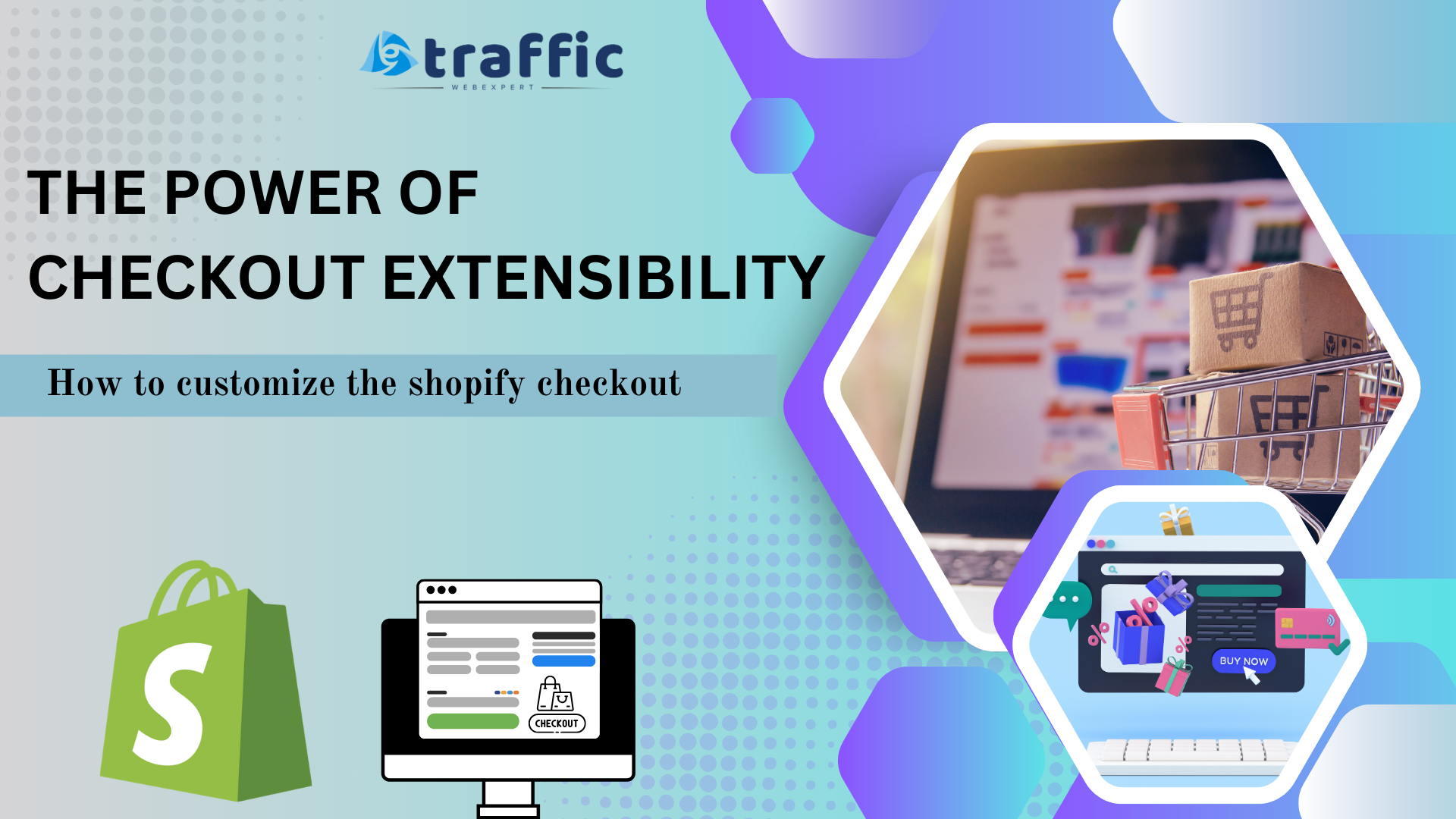Etraffic Webexpert
Unlocking the Potential of Checkout Extensibility in Shopify

Extending Checkout with CheckOut Extensibility in Shopify: A Comprehensive Guide
Shopify has become a popular platform for businesses to build and grow their online stores. One of the most important parts of an online store is the checkout process. To help businesses create a checkout experience that fits their needs, Shopify has introduced a feature called Checkout Extensibility.
This feature allows store owners to customize the checkout process, whether they want to offer special discounts, add new payment options, or change the design to match their brand. In simple terms, Checkout Extensibility gives businesses the flexibility to make the checkout experience work better for their customers and help increase sales.
In this blog, we'll walk you through some examples of checkout extensibility in Shopify and how you can enhance the customer experience.
What is Checkout Extensibility?
Checkout Extensibility in Shopify is a way for store owners and developers to customize the checkout process to meet specific business needs. It allows you to add new features, make the experience more personal, and improve how customers check out, all without changing Shopify's core code. This keeps things secure and compatible.

With Checkout Extensibility, you can:
1. Add custom fields for extra information during checkout.
2. Tailor the checkout process for different customer groups.
3. Add advanced features like upsells, cross-sells, or loyalty programs.
4. Integrate third-party apps and services directly into the checkout.
Before this, Shopify’s checkout process was more rigid, and customization was limited. Now, you can create a smoother, more engaging experience that helps boost conversions and fits your business goals.
How to Implement Checkout Extensibility in Shopify
To implement checkout extensibility in Shopify, you typically need to:
1. Shopify Plus Features: If you're on Shopify Plus, you have access to the checkout.liquid file, which allows full customization of the checkout process. Shopify Scripts, which are available for Plus users, can also be used for advanced pricing and discount logic.
2. Apps from Shopify’s App Store: Many third-party apps enable you to customize the checkout without needing coding knowledge. These apps can be easily installed and configured to suit your needs.
3. Shopify API: For even more control, Shopify provides APIs that allow for the integration of external services, custom payment methods, or logistics providers.
4. Liquid Templating Language: If you’re comfortable with coding, you can extend the checkout with Shopify’s Liquid template language, which allows for deep customization of the checkout process.
5. Custom Scripts (Shopify Plus): The Shopify Scripts editor is a powerful tool available only on Shopify Plus, allowing you to write custom scripts that modify checkout behavior, including discounts, shipping rules, and payment gateways.
Getting Started with Checkout Extensibility

1. Update Your Plan: Checkout Extensibility is available for Shopify Plus merchants. If you're not on Shopify Plus, you’ll need to upgrade your plan to unlock this feature.
2. Explore the Shopify Developer Docs: Shopify provides extensive documentation and tutorials to help developers get started with Checkout Extensibility. This includes guides on creating UI extensions and using Shopify Functions.
3. Leverage Pre-Built Apps: Not a developer? No problem. Shopify’s app ecosystem offers numerous apps that take advantage of Checkout Extensibility. These apps simplify the process of adding custom features to your checkout.
4. Test and Optimize: Once you’ve implemented changes, continuously test and optimize your checkout experience. Use analytics tools to track conversion rates and identify areas for improvement.
Examples of How Checkout Extensibility Works
1. Adding Custom Fields to the Checkout
A common use case for Checkout Extensibility is adding custom fields to the checkout page. Shopify allows you to add custom fields to the checkout page, which can be done by modifying the checkout liquid templates (for Shopify Plus users) or by using apps that integrate with Shopify.
Example: A jewelry store may want to ask customers for a personalized engraving message during checkout. You can easily add a text field to collect this information and include it in the order details for fulfillment.
Here's how you can do it:
a) Create a Custom Field: Using Shopify's Checkout UI extensions and App Extensions, developers can create custom fields (textboxes, dropdowns, radio buttons) on the checkout page. This data can then be saved and passed to the order information.
Example: A custom field for a gift message could look like this:
import {useExtensionApi, useField} from '@shopify/checkout-ui-extensions';
const GiftMessage = () => {
const {extensionApi} = useExtensionApi();
const field = useField('gift_message');
return (
<div>
<label htmlFor="giftMessage">Gift Message</label>
<textarea
id="giftMessage"
value={field.value}
onChange={e => field.setValue(e.target.value)}
placeholder="Add a personal message"
/>
</div>
);
};
export default GiftMessage;
b) Process the Custom Field Data: After checkout, the merchant can review the custom data (like the gift message) in the order details, or use it for future interactions like sending personalized thank-you emails.
2. Implementing Upselling and Cross-Selling
Upsells and Cross-Sells During Checkout Upselling and cross-selling can significantly boost your average order value (AOV). With Shopify's checkout extensibility, you can introduce additional products or offers at checkout. These features encourage customers to add more items to their cart before completing their purchase. For example, after a customer has added an item to the cart, a custom offer for a related product can appear in the checkout.
Example: Let's say a customer is purchasing a smartphone, and you want to offer them accessories like a case or charger. Using Shopify's Checkout UI extension, you could display the related product as an upsell.
import {useExtensionApi, useCheckout} from '@shopify/checkout-ui-extensions';
const UpsellOffer = () => {
const {checkout} = useCheckout();
const {extensionApi} = useExtensionApi();
const upsellProduct = {
productId: '12345',
title: 'Smartphone Case',
price: '19.99',
};
return (
<div>
<h3>Special Offer: Add a Case to Your Order</h3>
<button onClick={() => checkout.addLineItem(upsellProduct)}>
Add to Cart
</button>
</div>
);
};
export default UpsellOffer;
This allows merchants to add targeted product recommendations during the checkout process, increasing average order value (AOV).
3. Personalizing the Checkout Experience
Shopify's built-in discount features are powerful, but sometimes businesses require more advanced discount structures that are not available out of the box. Using Shopify's checkout extensibility features, store owners can implement conditional discounts, bundle discounts, or automatic cart discounts at checkout.
Example: A store selling home goods may want to offer a "Buy 2, Get 1 Free" deal or provide discounts based on the customer's location. These advanced discounting options can be implemented using Shopify's script editor or third-party apps. You could create a personalized checkout experience where returning customers receive a special discount code.
import {useExtensionApi, useCustomer} from '@shopify/checkout-ui-extensions';
const PersonalizedDiscount = () => {
const {customer} = useCustomer();
const {extensionApi} = useExtensionApi();
if (customer && customer.isReturning) {
return (
<div>
<h3>Welcome back! Use code 'WELCOME10' for 10% off</h3>
</div>
);
}
return null;
};
export default PersonalizedDiscount;
In this case, if the customer is recognized as a return shopper, they are shown a discount message. This enhances customer loyalty by rewarding repeat business.
4. Integrating Third-Party Apps
With Checkout Extensibility, Shopify allows merchants to integrate third-party apps and services directly into the checkout process. Order bumps are small, additional offers that appear during checkout, encouraging customers to add more products to their cart for a special deal or offer. This feature can be customized using third-party apps or Shopify Scripts.
A store selling skincare products might offer an “Add a Free Sample” option for just $1. This simple bump can increase the total cart value while providing the customer with an enhanced experience.

Example: If you use a third-party subscription service, you can add a custom subscription option during the checkout process.
import {useExtensionApi, useField} from '@shopify/checkout-ui-extensions';
const SubscriptionOption = () => {
const {extensionApi} = useExtensionApi();
const field = useField('subscribe');
return (
<div>
<label htmlFor="subscription">Subscribe for 20% off your next order</label>
<input
type="checkbox"
id="subscription"
checked={field.value}
onChange={() => field.setValue(!field.value)}
/>
</div>
);
};
export default SubscriptionOption;
By offering subscription services right within the checkout flow, merchants can tap into recurring revenue streams.
5. Customizing the User Interface (UI)
The checkout process should align with your brand’s aesthetic. Shopify provides some basic customization options, but for more advanced control over the look and feel of the checkout, you can use Liquid (Shopify’s templating language) to make changes to the design. For Shopify Plus users, this means full access to the checkout.liquid file.
Example: A boutique clothing store may want to adjust the checkout page design by adding custom branding, logos, colors, and fonts. You can also display trust badges and customer testimonials to further reassure buyers.
6. Integrating with Third-Party Payment Providers
Shopify supports various payment gateways, but depending on the region or business needs, you may want to integrate a third-party payment processor. Shopify allows you to extend the checkout process by adding additional payment methods beyond the standard Shopify Payments.
Example: If you're selling internationally, you may want to offer localized payment options like Alipay for Chinese customers or Klarna for Scandinavian markets. These integrations can be managed through Shopify Plus or custom apps.

7. Custom Shipping Options
Depending on your business model, you may want to provide customers with different shipping options at checkout. Shopify allows you to offer conditional shipping rates or even custom delivery methods based on factors like the customer’s location, order total, or product type.
Example: A furniture store could offer different shipping methods, such as "Standard Delivery," "White Glove Service," or "In-Store Pickup," depending on the region or the type of product being purchased. These options can be customized in the shipping settings or via the Shopify API.
Diagram: How Checkout Extensibility Works
|
+-----------------------+ +------------------------+ +----------------------------+ |
1. Shopify provides a robust Checkout UI
2. Developers add custom logic using UI Extensions or Functions.
3. The checkout experience integrates seamlessly, ensuring a cohesive user experience.
Why Checkout Extensibility Matters
The main advantages of Shopify's Checkout Extensibility include:
1. Customization without compromise: Customizing the checkout process without altering core Shopify code ensures that your store remains compatible with future Shopify updates and retains full functionality.
2. Increased conversions: Tailoring the checkout process to your audience can reduce cart abandonment. For instance, adding trust signals like secure payment badges or personalized messages reassures customers, boosting their confidence to complete purchases.
3. Better customer experience: Customizing the checkout to suit your customers’ needs can lead to smoother, more intuitive transactions, which in turn enhances customer satisfaction.
4. Enhanced Brand Identity: Your checkout is more than just a transaction page; it’s an opportunity to leave a lasting impression. With Checkout Extensibility, merchants can add custom styling, logos, and brand-specific colors to create a cohesive brand experience.
5. Upselling and Cross-Selling Opportunities: Merchants can showcase complementary products or limited-time offers during checkout, increasing the average order value (AOV) without disrupting the user experience.
6. Seamless Third-Party Integrations: Need to integrate loyalty programs, custom payment gateways, or analytics tools? Checkout Extensibility makes it easier to connect these tools directly within your checkout flow.

Conclusion
Shopify's Checkout Extensibility gives merchants and developers powerful tools to customize the checkout process, making it more effective and aligned with their brand and customer needs. You can add features like custom fields, upselling options, personalized offers, and integrations with third-party apps to turn your checkout into a revenue booster.
With these tools, you can improve the user experience, increase the average order value, and offer tailored options for your customers. Whether you’re adding advanced discounts, introducing new payment methods, or personalizing offers, the possibilities are endless.
In today’s fast-changing eCommerce world, having a flexible and optimized checkout process is essential to stay ahead of the competition. Shopify's tools allow you to create a seamless, branded checkout experience that drives conversions and makes shopping easier for your customers.
Remember "Your Customers’ Journey Doesn’t End at Checkout, It’s Just Getting Started.









